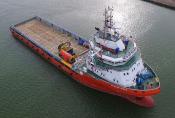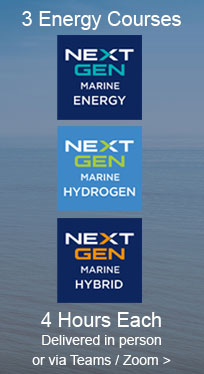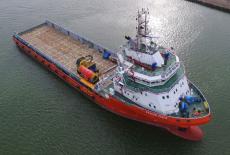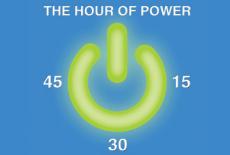How Can Marine Sectors Finance Hybrid Power

01.02.2022

Platform Support Vessel ‘SEACOR Maya’ is going Hybrid
Ports and the offshore industry are now recognising the potential of utilising hybrid power linked to innovative propulsion systems.
However, the cost of adopting hybrid technology on retrofit projects and new vessels requires a viable business case to justify higher capital expenditure (CAPEX). Operators cannot afford to go ‘green’ for no reason, there simply is not the margin to add on another layer of costs.
Maritime sectors need a viable business case or they need a compliance case. Which raises the burning question - how can the offshore sector finance hybrid marine power?
Other transport sectors around the world are successfully utilising hybrid systems. Automotive manufacturers including Tesla and BMW are re-defining energy possibilities for land transport. Standardisation is helping to reduce costs and the technology is transitioning from high performance cars to city busses and the future of aviation.
Technology Readiness Level (TRL) is rated 1 to 9. Component parts of maritime hybrid powertrains typically achieve TRL8. By definition this is, ‘actual system completed and qualified through test and demonstration’. But maritime needs to move up to TRL9, ‘actual system proven through successful mission operations’.
Emissions Compliance versus Engineering Efficiency
Dramatically reducing pollution in both water and air, particularly in ports and around people to maintain their health, is becoming the most significant driver for change in the maritime sector since coal and steam gave way to heavy fuel oil which has evolved into our current diesel fuels.
On a global scale, the International Maritime Organization (IMO) in 2018 adopted a strategy on the reduction of greenhouse gas (GHG) emissions from ships. The IMO set out a vision to reduce GHG emissions from international shipping and phase them out as soon as possible in this century. This is an ambitious commitment with targets to reduce emission levels of CO2, SOx, NOx and particulate matter.
Professional mariners already know about MARPOL legislation relating to marine pollution, plus the serious financial implications of vessels and operators getting it wrong. Emissions from internal combustion engines using fossil fuels will come at an increasingly heavy price over the next few years as countries, regions and individual maritime cities take action. Paris, London and Amsterdam will set high level air quality standards for rivers and estuaries that other ports will follow.
These drivers are encouraging offshore operators to rapidly become interested in next generation power. However approaching ‘hybrid’ energy use from a purely ’green’ or ‘compliance’ viewpoint may miss significant opportunities to improve engineering efficiency, improve safety and reduce operating costs.
Hybrid Marine Power meets Real World Metrics
Selecting power for vessels currently starts with identifying how many kilowatts or horsepower are required to move a vessel at the required cruising speed or maximum speed. Generators for house loads and other energy roles onboard are not usually included in the propulsion profile. With smart hybrid systems multiple generators can be integrated to deliver low speed propulsion, improve top end performance, including bollard pull, or deliver standby power to provide additional redundancy.
Propulsion choice is currently specific to each application and is defined by understanding the key performance measures which will make a commercial venture profitable or not. Conventional propellers, water jets, steerable pods or controllable pitch propellers may be selected to improve handling or to meet additional thrust requirements. With hybrid systems it will no longer be about top speed performance on sea trial. A new priority will be whether the propulsion system can be integrated into a hybrid system, then controlled with minimal input power. Battery-electric systems have the potential for ultra-low speed operations starting at one RPM for the propellers.
Hybrid vessel powertrains will inevitably be higher cost as more technology, engineering and software is required. Owners will need to know this clearly in advance if the primary concern is how quick to deliver return on investment. An issue will be identifying which parts of the technology, including engineering and controls, will last for the life of the vessel and which will need replacing at set intervals, for example batteries and management systems.
The requirement for ‘power’ is changing for offshore operations. The traditional operating model is moving people and goods from point to point as fast as possible. Computer modelling by universities and specialist analysts can be utilized when considering innovative power and propulsion systems. Projects will need to define and prioritise objectives with metrics. Standardisation of systems for both retrofit and new build projects will potentially help to reduce capital costs. But, many organisations will require real world data gathered at sea to convince them of the business case.
The Hour Of Power and Efficiency By All Means
The Hour Of Power is a hybrid concept using a combination of diesel and battery-electric to enhance conventional power and propulsion systems. This enables vessels to run in and out of port for an hour on electric with battery power, then carry out open sea work on diesel power, or loiter for significantly longer.
The Hour Of Power focuses on hybrid solutions linked to viable business cases. This is not just green energy for the sake of it. Many commercial harbours around the world have 10 knot speed limits for low wash or safety reasons and are within one hour of the sea.
Vessels can reduce emissions and improve fuel consumption, whilst extending engine maintenance periods and overall engine life. Vessels can use their conventional diesel engines and propulsion system, charge batteries when running diesels, charge batteries from shore power, run on battery-electric.
For commercial and professional organisations the simple concept of running vessels with zero emissions around ports will shape decisions that lead to improvements of in-service systems and procurement of next generation vessels. The overall objective is fuel saving and improved efficiency by all means.
Hybrid Solutions at Sea Level for Offshore Wind
The offshore wind industry has seen an improvement in power generation with increased capacity of each tower and overall fall in the price of generation. It now requires a greener solution for delivering engineers to turbine towers. Next generation hybrid vessels will need to be capable of charging their batteries at sea from wind generated energy when charging points become available on wind farms.
Offshore vessels could increase efficiency and reduce emissions. A variety of vessels, ranging from smaller Crew Transfer Vessels (CTV) typically 18 to 24m and Service Operations Vessels (SOV) typically 70 to 90m are used in the construction and operation of offshore wind turbines. Hybrid solutions lend themselves to the more predictable duty cycles for vessels used in the Operations and Maintenance (O&M) phase.
From Hybrid Concept to Offshore Application
A game changer in early 2018 was when SEACOR Marine announced fitting battery based hybrid energy storage systems on multiple Platform Support Vessels (PSVs). Four in-service PSVs owned by MEXMAR will be retrofitted for hybrid operation. The conversion of ‘SEACOR Maya’ is underway with other vessels scheduled. Six new hybrid PSV’s are under construction with Chinese partner COSCO, with first two deliveries this year and others in 2019 and 2020.
Tim Clerc, Manager of Engineering for SEACOR Marine, said, ‘We are confident in the energy saving and safety elements for SEACOR Maya and are keen to migrate more of our vessels to this environmentally friendly and highly efficient power solution. With the reduction of environmental impact fast becoming a key criteria for our clients, it’s important that we are able to meet the changing needs in the market.’
Typical vessel operations will utilize batteries to provide spinning reserve during critical vessel operations such as dynamic positioning. Also providing support for peak shaving, enabling diesel engines to operate more efficiently. Utilizing battery power will not only reduce the environmental footprint of the offshore operations but will significantly reduce operational costs, fuel consumption and engine maintenance.
Traditional Diesels linked to Battery-Electric Hybrid
- Reduce diesel engine hours on low load to extend engine life
- Reduce diesel engine hours to extend maintenance period
- Provide alternative power for redundancy and blackout
- Reduce diesel consumption which reduces the fuel bill
- Reduce emissions in port which enables compliance
- Increase green credentials to compete in tenders
How Offshore can utilise Hybrid Opportunities
- Quantify operating conditions
- Quantify the engine duty cycle
- Classify types of hybrid system
- Classify types of suitable vessels
- Model hybrid system and vessel combinations
- Identify viable funding routes and tax incentives
Looking To The Hybrid Future
There are clear opportunities related to next generation marine power, however the integration of products will be crucial. A single point of failure at sea will reflect on all OEMs in the hybrid power ‘system’.
As new sources of energy become available it is important to identify which will best fit the vessels operational requirements and engine duty cycle to give efficient power when it is needed. Since no two vessels, routes or captains are alike, decisions can be improved with data logging and analysis.
We need to be clear why certain applications are currently inefficient and understand how this relates to changes in energy use globally. We need to understand which offshore sectors are likely first adopters of hybrid systems and most importantly which countries will support and contribute to technology development.
By John Haynes info@shockmitigation.com
All images are copyright Hybrid Marine Power 2024 unless otherwise stated.
This does not exclude the owner's assertion of copyright over the material.
eNews
15.04.2024
MariNH3 Conference 2024
MariNH3 Conference 2024 is being held at Grand Plaza Hotel,…
eArticle
06.10.2023
Challenges of Unpredictable Marine Energy
From running Energy Transition training for significant maritime organisations technology…
Video
Round The World solar boat Turanor PlanetSolar
MS Tûranor PlanetSolar is the largest solar boat in the world. This 35 metre (115 feet) catamaran operates solely on…









